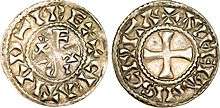Rudolph of France
| Rudolph | |
|---|---|
| King of the Franks (more...) | |
| Reign | 13 July 923 – 14/15 January 936 |
| Coronation | 13 July 923, St Médard, Soissons |
| Predecessor | Robert I |
| Successor | Louis IV |
| Born | c. 890 |
| Died |
14/15 January 936 (c. aged 45–46) Auxerre |
| Spouse | Emma of France |
| House | Bosonid |
| Father | Richard the Justiciar |
| Mother | Adelaide of Auxerre |
Rudolph (also Radulf, Ralph, or Raoul) (c. 880/890 – 14/15 January 936) was the King of France from 923 until his death. Prior to his election as king, he was Duke of Burgundy and Count of Troyes from 921. He was the son of Richard, Duke of Burgundy and Adelaide of Auxerre, and inherited the Duchy of Burgundy from his father. He married Emma of France, daughter of Robert I of France. This Rudolph is frequently confused with his uncle Rudolph I of Burgundy.
Rudolph was elected king of West Francia in 923 by an assembly of nobles, to succeed his father-in-law, and crowned by Walter, Archbishop of Sens, at St Médard in Soissons on Sunday, 13 July 923. On assuming the crown, he passed the Duchy of Burgundy to his younger brother, Hugh the Black, after only two years as duke. Charles III was still living and claiming the kingdom at the time, but Rudolph's brother-in-law, Herbert II, Count of Vermandois, who was married to Emma's sister, tricked Charles, a fellow Carolingian, into meeting him and took him prisoner. Rudolph's first act as king was to lead an army against Henry the Fowler, who had made a compact with King Robert at Jülich earlier in the year. Trying to annex Lorraine, the German monarch met Rudolph and a considerably-sized army and made peace again. Though, in 925, Henry attacked the waffling Gilbert, Duke of Lorraine, constantly changing sides, and wrested control of Lorraine from France permanently, Rudolph then being in no position to resist.

At about this point, 924, the Vikings made a fresh series of raids into West Francia. From the Loire Valley, they threatened Hugh the Great, brother of Emma, his wife, but Rudolph did nothing. Soon they had attacked Burgundy, domain of his own brother and were repulsed, moving to Melun, where they threatened the royal demesne. Joined only by his ecclesiastic vassals and Herbert, he recruited troops in Burgundy, while Hugh the Great was convinced to join him. The Vikings left, but the Normans, whom Charles had legally implanted around Rouen in 911, began ravaging that whole region. Herbert and Arnulf I of Flanders joined him this time and they took Eu, but were ambushed near Fauquembergues and the king was wounded, the Count of Ponthieu killed, and many Normans left dead on the field. Also in that year, Rudolph conversed with Louis the Blind, king of Provence, over the Magyars, the newest migrants to Europe, then menacing Louis. In 930, the Magyars invaded the region around Rheims, but left before the king could engage them. In 935, the Magyars invaded Burgundy and Rudolph brought a large army against them, causing their retreat without battle. France was temporarily safe from both Viking and Magyar at Rudolphs's death.
Herbert, however, was not to continue to be one of Rudolph's partisans. He used his royal prisoner as a bargaining tool to secure the archbishopric of Rheims for his son Hugh in 925 and the county of Laon for his other son Odo in 927. The protestations of Rudolph led Herbert to bring Charles before William Longsword, for homage and thence to Rheims to press Charles' claim on Pope John X. In 928, Herbert finally got possession of Laon, but the next year, Charles died at Péronne and Herbert lost his leverage against Rudolph. By defeating the Vikings of the Limousin, Rudolph received the allegiance of the Aquitainians and the homage of William Longsword, now duke.
In 929, Rudolph started trying to reduce the power of Ebalus, Duke of Aquitaine. He withdrew from him access to Berry, then, in 932, he granted the title of prince of Gothia to the count of Toulouse, Raymond Pons, and his brother of Rouergue, Ermengol. He also transferred the title Count of Auvergne to Raymond. Moreover, the territory of the march which was under the control of the lord of Charroux was transformed into an independent county. Later, however, he was campaigning with Ebalus in the south to eradicate the last Viking strongholds there. He then proceeded aggressively against Herbert, marching into Rheims and replacing Hugh with Artald (931). Then, joined by Hugh the Great, Rudolph burned Herbert's fortresses and cornered him in Château-Thierry, where he had first imprisoned Charles, from 933 to 934. The two made peace in 935 and Rudolph fell ill, dying a few months hence on 14 or 15 January 936.
Ancestry
| Ancestors of Rudolph of France | ||||||||||||||||||||||||||||||||||||||||||||||||||||||||||||||||||||||||||||||||||||||||||||||||||||||||||||||||||||||||||||||||||||||||||||||||||||||||||||||||||||||||||||||||||||||||||||||||||||||||||||||||||||||||||||||||||||||||||||||||||||||||||||||||||||||||||||||||||||||||||||||||||||||||||||||||||||||||||
|---|---|---|---|---|---|---|---|---|---|---|---|---|---|---|---|---|---|---|---|---|---|---|---|---|---|---|---|---|---|---|---|---|---|---|---|---|---|---|---|---|---|---|---|---|---|---|---|---|---|---|---|---|---|---|---|---|---|---|---|---|---|---|---|---|---|---|---|---|---|---|---|---|---|---|---|---|---|---|---|---|---|---|---|---|---|---|---|---|---|---|---|---|---|---|---|---|---|---|---|---|---|---|---|---|---|---|---|---|---|---|---|---|---|---|---|---|---|---|---|---|---|---|---|---|---|---|---|---|---|---|---|---|---|---|---|---|---|---|---|---|---|---|---|---|---|---|---|---|---|---|---|---|---|---|---|---|---|---|---|---|---|---|---|---|---|---|---|---|---|---|---|---|---|---|---|---|---|---|---|---|---|---|---|---|---|---|---|---|---|---|---|---|---|---|---|---|---|---|---|---|---|---|---|---|---|---|---|---|---|---|---|---|---|---|---|---|---|---|---|---|---|---|---|---|---|---|---|---|---|---|---|---|---|---|---|---|---|---|---|---|---|---|---|---|---|---|---|---|---|---|---|---|---|---|---|---|---|---|---|---|---|---|---|---|---|---|---|---|---|---|---|---|---|---|---|---|---|---|---|---|---|---|---|---|---|---|---|---|---|---|---|---|---|---|---|---|---|---|---|---|---|---|---|---|---|---|---|---|---|---|---|---|---|---|
| ||||||||||||||||||||||||||||||||||||||||||||||||||||||||||||||||||||||||||||||||||||||||||||||||||||||||||||||||||||||||||||||||||||||||||||||||||||||||||||||||||||||||||||||||||||||||||||||||||||||||||||||||||||||||||||||||||||||||||||||||||||||||||||||||||||||||||||||||||||||||||||||||||||||||||||||||||||||||||
Sources
- Gwatking, H. M., Whitney, J. P., et al. Cambridge Medieval History: Volume III—Germany and the Western Empire. Cambridge University Press: London, 1930.
| Preceded by Richard |
Duke of Burgundy 921–923 |
Succeeded by Hugh |
| Preceded by Robert I |
King of Western Francia 923–936 |
Succeeded by Louis IV |
| ||||||||
| ||||||||||||||||||||||||||||||||||||||||||||||||||
| ||||||||||||||||||||||||||||||||||||||||||||
|

.svg.png)